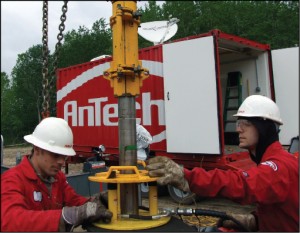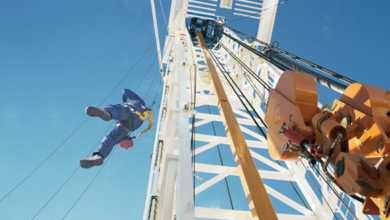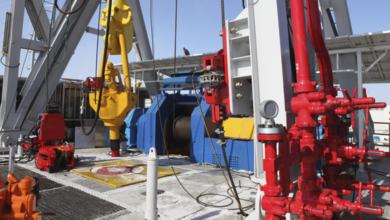Drilling & Completion Tech Digest
First Multi-Zone Single Trip installed in GOM dual producer
Superior Completion Services, a division of Superior Energy Services, recently completed its first Multi-Zone Single Trip (MST) installation in the Gulf of Mexico on a dual producer completion project. The well completion program involved four intervals with an isolation packer assembly in a larger casing size. This assembly made for the most intervals and the longest MST assembly installed in 7-in. casing to date. It also made for the first system to use a tapered service string for 9 5/8-in. and 7-in. casing.
The perforating and sand control operations on the four zones were completed in about four days, cutting in half the time these operations would have taken using typical stacked completion techniques. Sand control treatments were pumped on the four completion intervals in 27 hours. In addition, the MST system allows each zone to be tested individually. The well will produce the lower two zones as the long string and the upper two zones as the short string of a dual completion.
University center to get drilling simulator
 KCA DEUTAG has established a strategic alliance with Robert Gordon University to provide drilling and rig training from the university’s new Energy Center at its Aberdeen campus. The company will relocate its proprietary DART simulator (Drilling and Advanced Rig Training) facility to a new complex within the Energy Center, expected to open in 2013. DART provides a full-scale reproduction of an offshore platform or land rig, with touchscreen consoles for both driller and assistant driller. 3D graphics of the rig’s drill floor and automated or remotely controlled equipment are projected onto a 60-ft long cinema screen at the front of the drilling control room cabin. Robert Gordon University will use the facility for postgraduate training programs.
KCA DEUTAG has established a strategic alliance with Robert Gordon University to provide drilling and rig training from the university’s new Energy Center at its Aberdeen campus. The company will relocate its proprietary DART simulator (Drilling and Advanced Rig Training) facility to a new complex within the Energy Center, expected to open in 2013. DART provides a full-scale reproduction of an offshore platform or land rig, with touchscreen consoles for both driller and assistant driller. 3D graphics of the rig’s drill floor and automated or remotely controlled equipment are projected onto a 60-ft long cinema screen at the front of the drilling control room cabin. Robert Gordon University will use the facility for postgraduate training programs.
Mpact downhole motor drills 3,390 ft in 24 hrs, setting Barnett daily footage record
Mpact Downhole Motors set a Barnett Shale daily footage record on 3 September 2010 using an Mpact downhole motor. For a 24-hr period, the assembly drilled a total of 3,390 ft with an average rotating and sliding ROP of 167.95 ft/hr.
The well, Little Hoss X5H, was drilled for Chesapeake Energy using the rig Patterson 178. The motor was configured with a high-torque, slow-speed performance power section that incorporated Mpact’s premium stator elastomer. An 8 ½-in. bearing stabilizer was attached to the lower assembly, and the proprietary adjustable bearing housing was set at 1.83˚.
10% production growth targets reached on Iraq’s Zubair, Rumaila fields
Key production growth targets have been reached on Iraq’s Zubair and Rumaila fields in recent months. In late 2010, Occidental Petroleum (Oxy) and Korea Gas Corp (KOGAS) said they achieved and sustained a 10% increase in oil production on Zubair, near Basra in southern Iraq. Then in early 2011, the Rumaila Operating Organization (ROO) announced it had increased production by more than 10% above the 1.066 million bbl/day initial production rate agreed in late 2009.
On Zubair, production has grown to more than 200,000 bbl/day of oil from the approximately 183,000 bbl/day produced when the consortium started field operations in Q1 2010. Aside from Oxy and KOGAS, the consortium also includes Eni and the Missan Oil Co. Iraq’s state-owned South Oil Company (SOC) and Missan are serving as state partners. The consortium plans to increase production from the Zubair field to 1.2 million bbl/day within the next six years and to maintain that production for seven years thereafter.
ROO, established by PetroChina, BP and SOC, has worked to steadily build activity on Rumaila over the past year. A total of 20 new rigs are mobilized in the field. Since the technical service agreement was signed in late 2009, a total of 31 wells have been drilled, 103 workovers completed and 122 kilometers of flowlines laid. Some 10,000 people are now working on Rumaila. The first phase of a new headquarters and accommodations complex has been completed.
Coiled-tubing drilling BHA used for underbalanced drilling

UK-based AnTech has completed two drilling operations with the COLT, a coiled-tubing drilling bottomhole assembly (BHA) designed for the re-entry and thru-tubing markets. The tool was used on two wells in shale gas reservoirs in the Northeastern United States.
First field test
In the first field test, the well had originally been drilled conventionally with jointed pipe, but well problems meant that casing could not be run to TD. To re-drill the reservoir section would require drilling out a cement plug at the bottom of the casing, creating a new well trajectory and drilling a new horizontal section.
A rig with 2 3/8-in. diameter coil with e-line was brought to the well site, along with surface infrastructure and fluid tanks, a workshop trailer and a crane. Custom alignment tools and tool-handling equipment with hydraulically powered pistons were used to control deployment of the tool, which took just over two hours.
Drilling operations were performed in three stages: drilling the plug at the casing shoe, then the curve or “build” section, and the horizontal.
First, the COLT was run into the hole, and drilling commenced upon reaching the plug. It drilled through the plug and continued drilling for 165 ft with a straight motor and a tri-cone bit.
After drilling the plug, the operator set a well path; the challenge was to drill a build section that would effectively bring the well into a horizontal configuration. Setting a bend angle of 1.5˚ on the motor and aiming the toolface toward the desired direction, a build rate of 20°/100 ft was achieved. The operation was carried out using formation water as the drilling fluid. A 3 1/8-in. motor and a PDC bit were used to drill 460 ft to bring the wellbore horizontal at the desired depth.
The final step was to drill horizontally until the wellbore intersected the gently dipping formation above. While the previous two sections were drilled with formation fluid, the last section would be drilled underbalanced with nitrogen. Aerated fluids increase vibration and make it more difficult to see motor stalls by monitoring surface pressures. The immediate effect of the underbalance condition doubled the ROP as the overbalanced pressure was reduced.
The wireline telemetry used in the COLT meant that the signal transmission was not affected by the change in fluid, and the fast signal transmission and downhole weight and torque (WOB/TOB) sensors meant that stalls could be avoided by monitoring the downhole signals. The tool’s performance was not adversely affected by the increase in vibration. The borehole target was reached as planned.
Well Test 2
On a nearby commercial well, AnTech was to use the COLT to extend and drill a sump. The well was drilled in one run, with an extension and an open-hole sidetrack for a sump.
The COLT was used in combination with a 3 1/8-in. motor that had a 3 3/8-in. bearing section. It was drilled with an air-foam mix at an initial flow rate of 700 scf/min and 10 gpm, which was then increased to 900 scf/min and 10 gpm. At a TVD of 1,340 ft, the lateral was extended by 215.5 ft and a 255-ft sump was successfully drilled.
Using coiled-tubing drilling techniques, underbalance can be maintained 100% of the time. There are no joints to make and break, and downhole pressures are monitored continuously to ensure that they do not fall above or below planned values. In addition to the fast running speeds, continuous pressure containment and no personnel required on the rig floor, coiled-tubing drilling is an attractive proposition. In some cases it is the only viable way to drill a re-entry.
Since these operations, AnTech has implemented design improvements and created POLARIS, a simpler tool scheduled to debut in 2011. It is suitable for commodity drilling markets.



